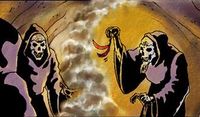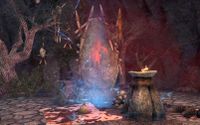
|
Reachman Shamans, also known as Witchmen,[nb 1][1] are Reachfolk responsible for the spiritual guidance of their clans.[2] Reachfolk approach to religion varies from clan to clan. They worship many spirits, both great and minor. There are many different, yet similar faiths in the Reach. Shamans of different clans follow different traditions, have different beliefs, and are responsible for appeasing and veneration of the different spirits.[3][4][5] They often act as religious leaders of their clans.[4]
The religion of Reachfolk is transactional in nature. Their relationship with the spirits relies on negotiation rather than on reverence.[2]
Shamans in training are known as Apprentices.[6][4] It was a universal title among the clans of the Reach used to refer to shamans in training, both in the city of Markarth and outside its area of control.[7] A Shaman usually chooses their Apprentice, but occasionally a willing candidate may petition the shaman themselves to become their pupil.[6]
Further InformationEdit
Shamans of some Reachfolk clans venerate hagraven matrons, who in turn grant them knowledge of nature magic.[1]. Other sources connect this magic directly with Hircine.[8] Thornroot Clan shamans worked alongside hagravens and were turning the captives into Briarhearts forcefully stripped of their free will. They used special, blessed tools that allowed them to desecrate the ritual without angering the spirits.[9]
Shaman and Apprentice of the Crow-Eye Clan were responsible for protecting the village of Karthwasten from harm by keeping magical wards devoted to four Great Spirits of the Reach. Although the clan was primarily following the Nocturnal, they also were making offerings to Hircine, Namira and Molag Bal to maintain the defensive wards. In 2E 582, the Icereach Coven began performing Harrowstorm rituals throughout Western Skryim and the Reach; stealing the souls of its residents to resurrect the Gray Host. Karthwasten was a target of one of such attacks. Despite suffering losses, the Reachfolk of Karthwasten survived, largely thanks to the magical protection Crow-Eye Clan maintained.[6][4]
The name "gravesinger" is given to some Reachman necromancers who broker deals with Molag Bal[10] in exchange for the power to command the loathsome dead. They are believed by some to be the most dangerous kind of Reachfolk shaman.[1] Gravesingers are necromancers who seek dominion over life and death. They were known to invoke Daedra lurking in darkness to assist in their dark pursuits.[11] Not all gravesingers are of Reacholk descent; there are also known Imperial gravesingers.[12]
Numerous shamans were affiliated with Wayward Guardians. Circa 2E 582, the organization sent the adventurer to recover the blue gems[13] embedded within the Dwemer Architons, the kind of Dwemer Animunculi known to be typically imbued with Aetherium.[14] The constructs were guarding the recently rediscovered Library of Arkthzand. They claimed that these gems possessed powerful enchantments and hoped to use them to arm themselves and their people against the encroaching forces of Rada al-Saran's Gray Host.[15]
The Shrine of the Hunt-Father was a Reachfolk temple based in Markarth. It was dedicated to five aspects of one of the Great Spirits of the Reach, Hircine. The shrine was active during the Interregnum in Second Era.[5]
Circa 2E 582 a group of shamans has shown interest in studying the mysterious magically imbued mushrooms of the Gloomreach. They also requested mercenaries to prevent a mad Psijic mage from conducting magical experiments on the eggs of dangerous insects in the area.[9]
Members of the Dreadhorn Clan utilized shamanistic magic associated with Kyne.[UOL 1] Their shamans often coated their skins in a chalky whitewash and painted symbols and sigils of power using mixed nirncrux powder and blood as paint.[16]
Reachmen celebrate the end of the old year and the beginning of the new year. They believe that with the coming of the New Life Festival, two of Hircine's aspects come to conflict with each other. New Life marks the winter solstice when the days begin to lengthen due to the return of the sun. Storihbeg the Man-Beast thus pursues the sun in an attempt to eat it, an effort to keep the nights longer. Reachfolk Shamans play important role in the celebrations. To prevent this, they summon Hrokkibeg, the Mighty Bear to keep Storihbeg constrained and protect Magnus. It is commonly understood by the Reachfolk Shamans that Hircine "abides in aspects five". Shamans know "which guise shall come and which must perforce go".[17]
Circa 2E 582, a Reachman shaman known as Uraccanach the Witchman advocated for the worship of Five Aspects of the Hircine.[18] Similarly to the shamans of the Shrine of the Hunt-Father he believed that there are only five aspects of Hircine that are worthy of recognition.[5][19] He was also a proponent of emulating the apparel of Huntsmen as an act of honoring the aspects of Hircine.[20]
Some shamans of Namira possess the ability to predict the future through examination of animal entrails.[21] Mysticism was another common magical art among the Reachfolk mystic shamans during the Second Era.[22]
In the ancient times Nordic invaders built Valthume. It was a place of worship of Nordic totem-gods. They attempted to convert native Reachfolk to their faith, but their attempts were met with an opposition and eventually they were killed by the locals. Shamans of the ancient past were believed to paint runes with their spilled blood.[23]
Notable ShamansEdit
- Angof — Infamous gravesinger who was a leader of the Bloodthorn Cult.
- Baircallas — The Shaman known for his ability to read future through examination of animal entrails.
- Glynroch — The first High Shaman of the Shrine of the Huntfather and keeper of the Symbols of the Five Aspects.
- Mochtuinne Eye-Tooth — The shaman knowledgeable about the traditions of both the Old Life and New Life festivals.
- Uraccanach the Witchman — Reachfolk author and proponent of the worship of the Five Aspects.
- Ulvoch — Spiritual leader of Karthwasten during the Three Banners War.
NotesEdit
See AlsoEdit
BooksEdit
- Aspects of Lord Hircine by Juno Procillus, Academy of Chorrol — Transcribed statement detailing the five aspects of the Daedric Prince Hircine
- The Improved Emperor's Guide to Tamriel: Northern Bangkorai and the Mountains by Flaccus Terentius
- Great Spirits of the Reach by Vashu gra-Morga, Chief Daedrotheologist at the University of Gwylim — A treatise on some of the major figures in Reach theology
ReferencesEdit
- ^ a b c The Improved Emperor's Guide to Tamriel: Northern Bangkorai and the Mountains — Flaccus Terentius, 2E 581
- ^ a b Shaman Ulvoch's dialogue in ESO: Markarth
- ^ Great Spirits of the Reach: Volume 2 — Vashu gra-Morga, Chief Daedrotheologist at the University of Gwylim
- ^ a b c d Events of After the Storm in ESO
- ^ a b c High Shaman Glynroch's dialogue in ESO: Markarth
- ^ a b c Apprentice Fialyn's dialogue in ESO: Markarth
- ^ Apprentice Orla's dialogue in ESO: Markarth
- ^ Vernim Woods' loading screen
- ^ a b Bralthahawn's dialogue in ESO
- ^ Zhagush gro-Korlag's dialogue in ESO
- ^ Guardian of the Earth's dialogue in ESO
- ^ Gravesinger card in Legends
- ^ Arkthzand Gemstone quest item description in ESO
- ^ Crafting Motif 96: Arkthzand Armory Style — Mathinn Palard, University of Gwylim
- ^ Ardanir's dialogue during The Light of Arkthzand in ESO
- ^ Dreadhorn Shaman skin description in ESO
- ^ New Life Festival Interview — Countess Aurorelle Edrald, Marwig Yeomcroft, Priestess Phaziyya, and Mochtuinne Eye-Tooth
- ^ Crafting Motif 31: Skinchanger Style — Uraccanach the Witchman
- ^ Aspects of Lord Hircine — Juno Procillus, Academy of Chorrol
- ^ Crafting Motif 65: Huntsman Style — Uraccanach the Witchman (as transcribed by Juno Procillus, Academy of Chorrol)
- ^ Witchman Baircallas' dialogue in ESO
- ^ Ree-Zish's dialogue in ESO
- ^ Valthume's loading screen in ESO: Markarth
- ^ Rolbert Foucher's dialogue in ESO
- ^ Pocket Guide to the Empire, 1st Edition: High Rock — Imperial Geographical Society, 2E 864
- ^ High Chancellor's Papers: The Tagh Droiloch — Abnur Tharn
Note: The following references are considered to be unofficial sources. They are included to round off this article and may not be authoritative or conclusive.
- ^ Developer comments on Dreadhorn Clan (24:40) on ESO Live
